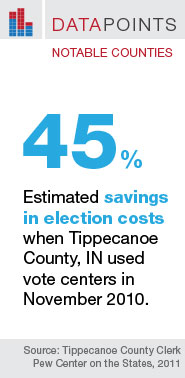Notable Counties-Tippecanoe County, Ind.
Return to Election Data Dispatches.
Today, Election Data Dispatches begins an occasional feature called “Notable Counties.” We’ll focus on local jurisdictions that provide in-depth, publicly available data that go well beyond basic voting results.
In 2007, Tippecanoe County, Ind., home of Purdue University, shifted from precinct-based elections to vote centers. This allows people to cast a ballot at any available voting location, regardless of where they live in the county. Since the change, the county has issued several post-election reports evaluating how the centers performed and how much they cost.
The most recent report, after the 2010 general election, showed:
- Turnout among rural voters was slightly higher than turnout for the entire population.
- The election cost $1.90 per vote, not including fixed costs. The county estimated it would have cost $3.45 per vote if the election had been run with traditional precincts.
If you know of a “notable county” using data in interesting ways, let us know.












